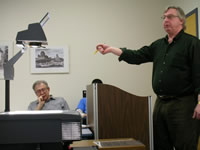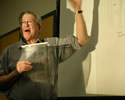28 February 2006
Explanation and Information
 Tag
team matches usually arise only in professional wrestling. Today,
our lunchtime colloquium was given by a tag team of two senior scholars,
Jim Bogen and Peter Machamer, and they weren't wearing spandex.
Their topic was information and how the notion is used in explanations
in science. Scientists use that word "information" all the time
when they explain what is really going on in one process or another.
It is used when they explain how sensors on a leech's body fires
due to an external stimulus and produces the appropriate life saving
response; or when the biochemistry of a cell allows the DNA to be
expressed; or when the "TH" mechanism lets an organism respond to
a fearsome snake. Tag
team matches usually arise only in professional wrestling. Today,
our lunchtime colloquium was given by a tag team of two senior scholars,
Jim Bogen and Peter Machamer, and they weren't wearing spandex.
Their topic was information and how the notion is used in explanations
in science. Scientists use that word "information" all the time
when they explain what is really going on in one process or another.
It is used when they explain how sensors on a leech's body fires
due to an external stimulus and produces the appropriate life saving
response; or when the biochemistry of a cell allows the DNA to be
expressed; or when the "TH" mechanism lets an organism respond to
a fearsome snake.
 For
over fifty years, information theory has meant the mathematical
theory of communication devised by Shannon and Weaver and used to
great success in the communication industry. Alas, that theory eschews
discussion of exactly the aspects of information that matter most
in Bogen and Machamer's examples: there are no meanings for the
information--it's not about anything; and there a no goals. All
the mechanisms Bogen and Machamer discuss have both and the information
talk is intimately connected with them. So, standing before a packed For
over fifty years, information theory has meant the mathematical
theory of communication devised by Shannon and Weaver and used to
great success in the communication industry. Alas, that theory eschews
discussion of exactly the aspects of information that matter most
in Bogen and Machamer's examples: there are no meanings for the
information--it's not about anything; and there a no goals. All
the mechanisms Bogen and Machamer discuss have both and the information
talk is intimately connected with them. So, standing before a packed
room, the speakers set about explaining their efforts to devise
a better theory that would have both meanings and purposes. Soon
transparencies with details of one or other mechanism in bio-this
or neuro-that were flashing over the screen; and their 50 minute
speaking time flew by. The discussion period was energetic. Wasn't
this really a theory of specificities? Wasn't this really just an
exercise in anthropomorphism (I incautiously asked)? No, No, came
the lightning reply and then a thunderstorm of reasons.
And there were no more donuts. They had all vanished early in the
event.
John D. Norton
Peter Machamer & James Bogen, U. Pittsburgh, History & Philosophy
of Science
Tuesday, 28 February 2006
12:05pm, Cathedral of Learning
:::
Explanation
and Information
:::
Lunchtime Colloquium
|


![]()
![]()

